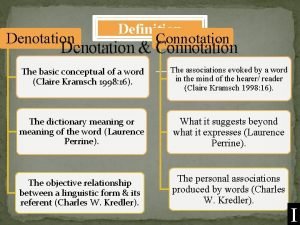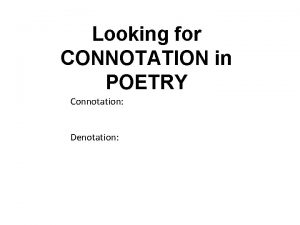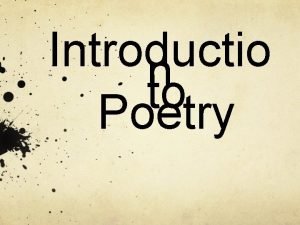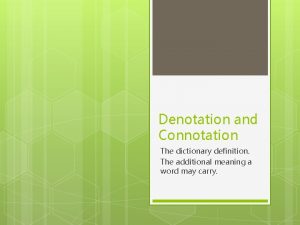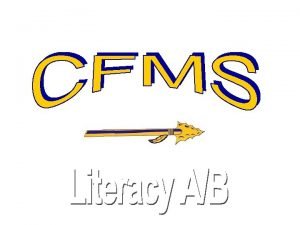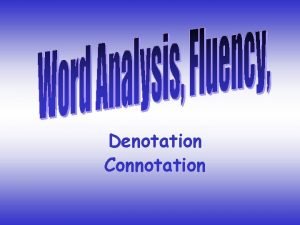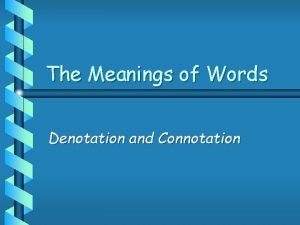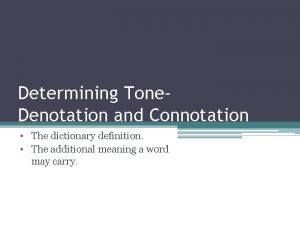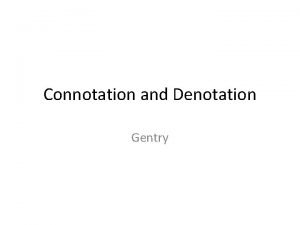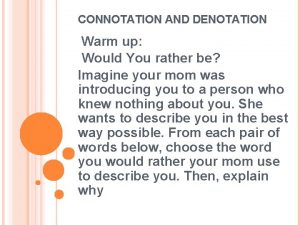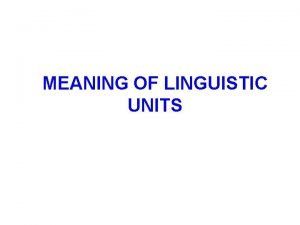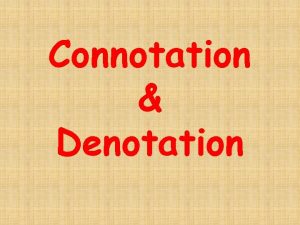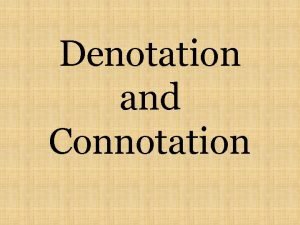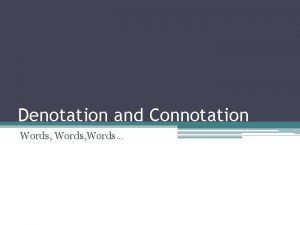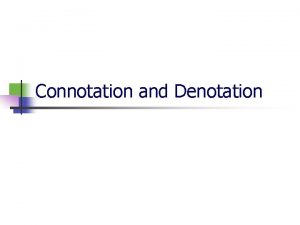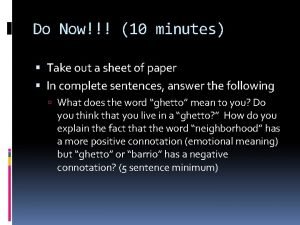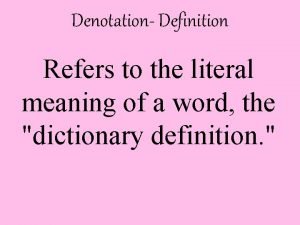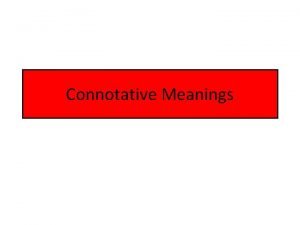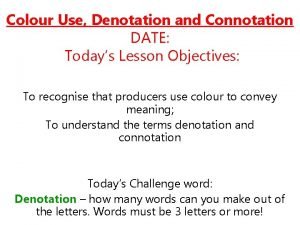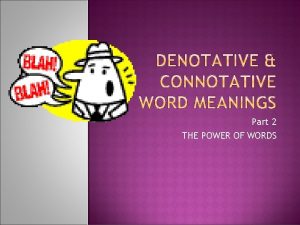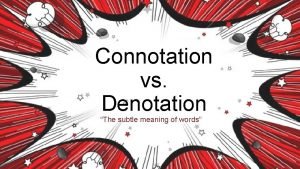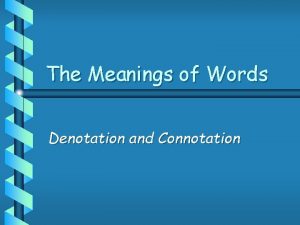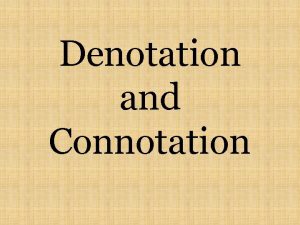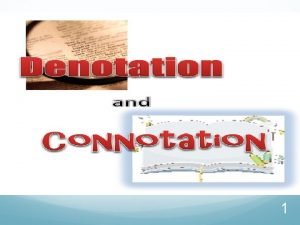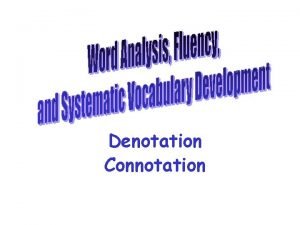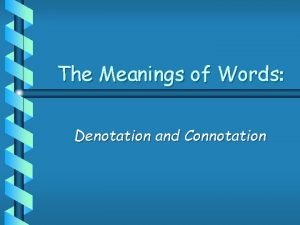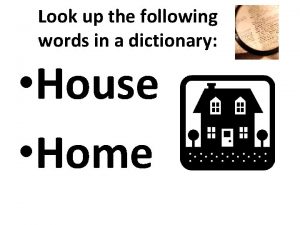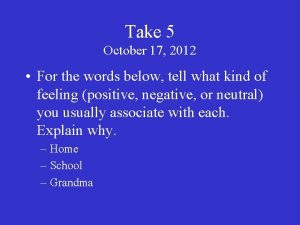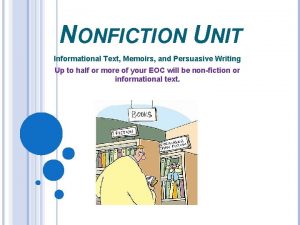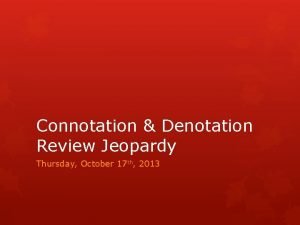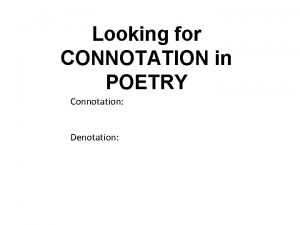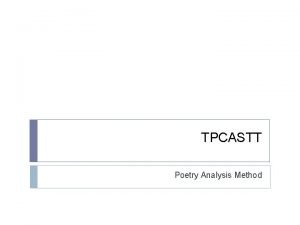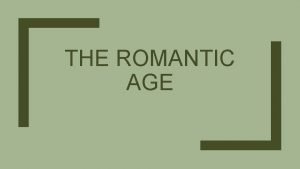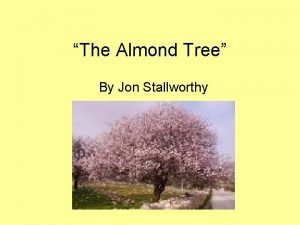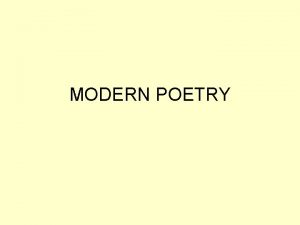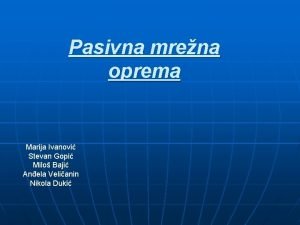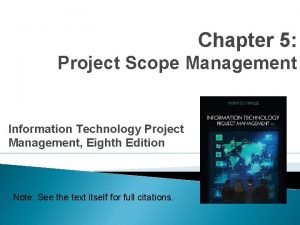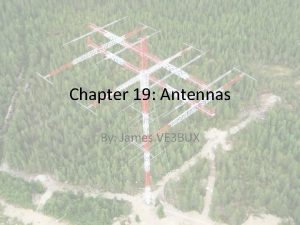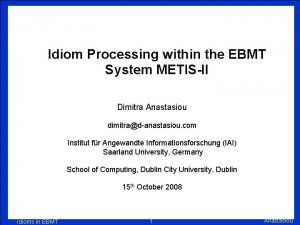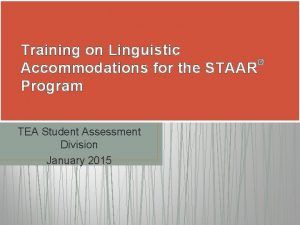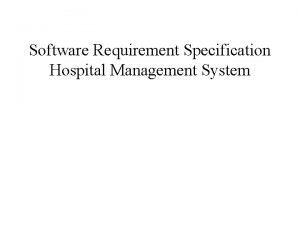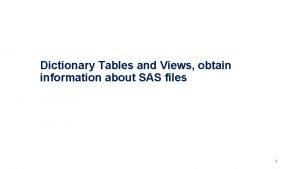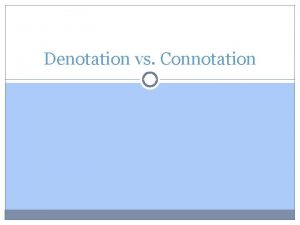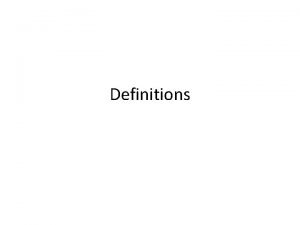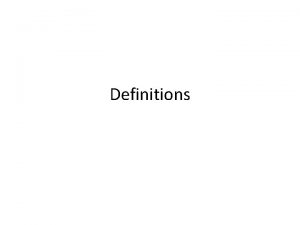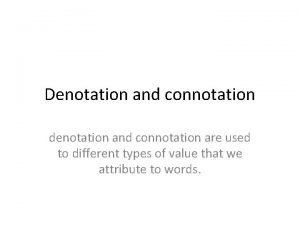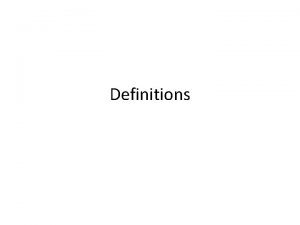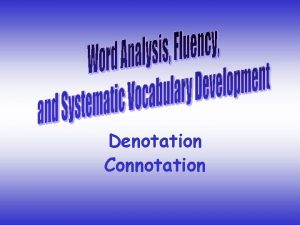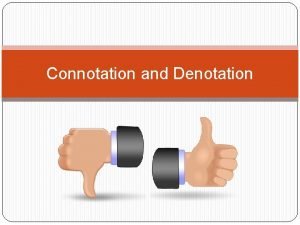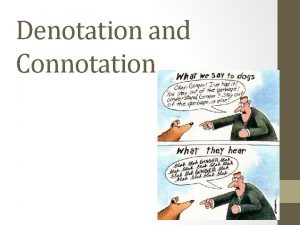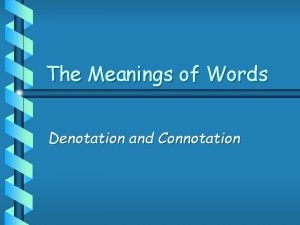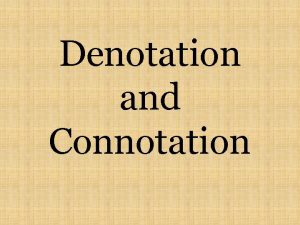Introductio n to Poetry Denotation Connotation Dictionary or




















































- Slides: 52

Introductio n to Poetry

Denotation Connotation Dictionary or literal meaning Implied, interpreted, or suggested meaning Example: It’s raining cats and dogs If you look outside, cats and dogs are falling from the sky. It is raining really hard outside.

Figurative Language Metaphor Direct Metaphor Implied Metaphor Simile Personification

Why is Figurative Language Significant in Poetry? Symbolism Concise Language Makes Language Livelier Writers Use Them Without Stating Obvious Gives Words New Meaning

Love is Blind I Smell a Rat Winds of Change You’re Ice cold Light of My Life Rolling in Dough What Is A Metaphor? Apple of my eye Heart of stone The Sweet Smell of Success The World Is a Stage… Bite the Bullet Let the Cat Out of the Bag

True Definition of Metaphors Makes Comparisons Between Two Unrelated Subjects Expands the Sense and Clarifies Meaning

Metaphor Direct Metaphor Comparing two unlike objects or ideas My love is a rose

Metaphor, Continued Indirect metaphor - An indirect comparison between two unlike things. “My love has a rosy bloom”

Simile A comparison using like or as “Life is like a box of chocolates”

Personification Giving human qualities to an inanimate object “The moon smiled down on the lovers”

Sound Techniques Rhyme Scheme Alliteration Onomatopoeia

Rhyme Scheme Heavy is my heart, Dark are thine eyes Thou and I must part Ere the sun rise A B

Rhyme Scheme- The pattern in which end rhyme occurs • Example: Continuous as the stars that shine (A) And twinkle on the milky way, (B) They stretched in never-ending line (A) Along the margin of a bay: (B) Ten thousand saw I at a glance, (C) Tossing their heads in sprightly dance. (C)

Alliteration Repetition of the initial consonant sound “She sells seashells at the sea shore”

ALLITERATION Consonant sounds repeated at the beginnings of words If Peter Piper picked a peck of pickled peppers, how many pickled peppers did Peter Piper pick?

Onomatopoeia A word whose sound imitates its meaning

More onomatopoeia “The bee buzzed by my ear “ “The clock ticked down the final hour” “The engine purred while awaiting the green light”

Stanza • A unit of lines grouped together • • Similar to a paragraph in prose

Couplet- • A stanza consisting of two lines that rhyme Quatrain - • A stanza consisting of four lines

Mood- the feeling a poem creates for the reader Tone - the attitude a poet takes toward his/her subject

Imagery • Representation of the five senses: sight, taste, touch, sound, and smell • Creates mental images about a poem’s subject • Example: “Continuous as the stars that shine and twinkle on the milky way”

Symbol • A word or object that has its own meaning and represents another word, object or idea • • Example: The daffodils represent happiness and pleasure to the author.

Assonance • The repetition of a vowel sound in two or more words in the line of a poem • • Example: “Which is the bliss of solitude”

Pronunciation Key for Vowels Ā = (Long a) Ē = (Long e) Ī = (Long i) Ō = (Long o) Ū = (Long u) Ä = (Short a) Ë = (Short e) Ï = (Short i) Ö = (Short o) Ü = (Short u)

ASSONANCE Repeated VOWEL sounds in a line or lines of poetry. (Often creates near rhyme. ) Lake Fate Base (All share the long “a” sound. ) Fade

ASSONANCE cont. Examples of ASSONANCE: “Slow the low gradual moan came in the snowing. ” - John Masefield “Shall ever medicine thee to that sweet sleep. ” - William Shakespeare

CONSONANCE Similar to alliteration EXCEPT. . . The repeated consonant sounds can be anywhere in the words “silken, sad, uncertain, rustling. . “

Refrain • The repetition of one or more phrases or lines at certain intervals, usually at the end of each stanza • Similar to the chorus in a song

Repetition • A word or phrase repeated within a line or stanza • • Example: “gazed and gazed”

POETRY

POETRY Ø A type of literature that expresses ideas, feelings, or tells a story in a specific form (usually using lines and stanzas)

POINT OF VIEW IN POETRY POET The poet is the author of the poem. SPEAKER The speaker of the poem is the “narrator” of the poem.

POETRY FORM - the appearance of the words on the page LINE - a group of words together on one line of the poem STANZA - a group of lines arranged together A word is dead When it is said, Some say. I say it just Begins to live That day.

FREE VERSE POETRY Does NOT have rhyme. Free verse poetry is very conversational sounds like someone talking with you. A more modern type of poetry.

BLANK VERSE POETRY from Julius Ceasar Written in lines of iambic pentameter, but does NOT use end rhyme. Cowards die many times before their deaths; The valiant never taste of death but once. Of all the wonders that I yet have heard, It seems to me most strange that men should fear; Seeing that death, a necessary end, Will come when it will come.

RHYME Words sound alike because they share the same ending vowel and consonant sounds. LAMP STAMP á Share the short “a” vowel sound (A word always rhymes with itself. ) á Share the combined “mp” consonant sound

END RHYME A word at the end of one line rhymes with a word at the end of another line Hector the Collector Collected bits of string. Collected dolls with broken heads And rusty bells that would not ring.

INTERNAL RHYME A word inside a line rhymes with another word on the same line. Once upon a midnight dreary, while I pondered weak and weary. From “The Raven” by Edgar Allan Poe

SLANT RHYME a. k. a imperfect rhyme, close rhyme The words share EITHER the same vowel or consonant sound BUT NOT BOTH ROSE LOSE á Different vowel sounds (long “o” and “oo” sound) á Share the same consonant sound

Slant Rhyme Said; read Led; need

SOME TYPES OF POETRY WE WILL BE STUDYING

LYRIC A short poem Usually written in first person point of view Expresses an emotion or an idea or describes a scene Do not tell a story and are often musical (Many of the poems we read will be lyrics. )

HAIKU A Japanese poem written in three lines An old silent pond. . . A frog jumps into the pond. Five Syllables Seven Syllables Five Syllables Splash! Silence again.

CINQUAIN A five line poem containing 22 syllables How frail Above the bulk Two Syllables Of crashing water hangs Four Syllables Autumnal, evanescent, wan Six Syllables The moon. Eight Syllables Two Syllables

SHAKESPEAREAN SONNET A fourteen line poem with a specific rhyme scheme. The poem is written in three quatrains and ends with a couplet. The rhyme scheme is abab cdcd efef gg

NARRATIVE POEMS A poem that tells a story. Generally longer than the lyric styles of poetry b/c the poet needs to establish characters and a plot. Examples of Narrative Poems “The Raven” “The Highwayman” “Casey at the Bat” “The Walrus and the Carpenter”

CONCRETE POEMS In concrete poems, the words are arranged to create a picture that relates to the content of the poem.

OTHER POETIC DEVICES

Hyperbole Exaggeration often used for emphasis.

Litotes Understatement - basically the opposite of hyperbole. Often it is ironic. Ex. Calling a slow moving person “Speedy”

Idiom An expression where the literal meaning of the words is not the meaning of the expression. It means something other than what it actually says. Ex. It’s raining cats and dogs.

Allusion comes from the verb “allude” which means “to refer to” An allusion is a reference to something famous. A tunnel walled and overlaid With dazzling crystal: we had read Of rare Aladdin’s wondrous cave, And to our own his name we gave. From “Snowbound” John Greenleaf Whittier
 Positive connotation for overweight
Positive connotation for overweight Denotation definition in poetry
Denotation definition in poetry Positive connotation
Positive connotation Connotation in poems
Connotation in poems Denotation in poetry examples
Denotation in poetry examples Negative connotation examples
Negative connotation examples Player denotation
Player denotation Brutal connotation
Brutal connotation Connotation and denotation jeopardy game
Connotation and denotation jeopardy game Denotation and connotation of hot
Denotation and connotation of hot Rose connotation
Rose connotation Denotation and connotation of hot
Denotation and connotation of hot Linguistic units
Linguistic units Denotation connotation and myth
Denotation connotation and myth Aggressive denotation
Aggressive denotation Connotation literary device
Connotation literary device Chicken denotation and connotation
Chicken denotation and connotation Connotation and denotation jeopardy game
Connotation and denotation jeopardy game Fat connotation
Fat connotation Denotation and connotation of home
Denotation and connotation of home Denotation of pig
Denotation of pig Monkey denotation and connotation
Monkey denotation and connotation Cheap denotation and connotation
Cheap denotation and connotation Denotation and connotation of blue
Denotation and connotation of blue Bony denotation
Bony denotation Heart connotation
Heart connotation Connotation examples
Connotation examples Denotation and connotation of chicken
Denotation and connotation of chicken Rose denotation
Rose denotation Denotation of dove
Denotation of dove Extraordinary connotation
Extraordinary connotation Denotative meaning
Denotative meaning Look at the following words
Look at the following words Connotation and denotation
Connotation and denotation Green denotation and connotation
Green denotation and connotation Positive connotation of plain
Positive connotation of plain Dog denotation and connotation
Dog denotation and connotation Connotation and denotation jeopardy game
Connotation and denotation jeopardy game Connotation in poetry
Connotation in poetry What is tpcast
What is tpcast Augustan poetry aim
Augustan poetry aim Define metaphysical poetry
Define metaphysical poetry Almond trees poem
Almond trees poem Experimentation in modern poetry
Experimentation in modern poetry Narrative poem definition
Narrative poem definition Diversity oxford dictionary
Diversity oxford dictionary Marija urban dictionary
Marija urban dictionary Dictionary entry sample
Dictionary entry sample Bux urban dictionary
Bux urban dictionary Dimitra urban dictionary
Dimitra urban dictionary Cf meaning
Cf meaning Activity diagram for hospital management system
Activity diagram for hospital management system Sas dictionary.tables
Sas dictionary.tables

